Dissertation: Leadership and Organisational Growth - Stanley Security
VerifiedAdded on 2023/06/12
|54
|15705
|432
Thesis and Dissertation
AI Summary
This dissertation investigates the role of leadership in improving organisational growth, using Stanley Security as a case study. The research employs a quantitative analysis method, surveying 50 employees to understand how leadership impacts employee skills, motivation, and productivity. The findings indicate that leadership significantly contributes to employee development and motivation within Stanley Security, although some respondents noted areas for improvement in charismatic leadership. The study recommends that Stanley Security invest in leadership development programs to enhance soft skills and teamwork, ultimately improving organisational performance. Limitations include time constraints affecting secondary data analysis. Desklib offers this dissertation, alongside other study resources, to aid students in their academic pursuits.
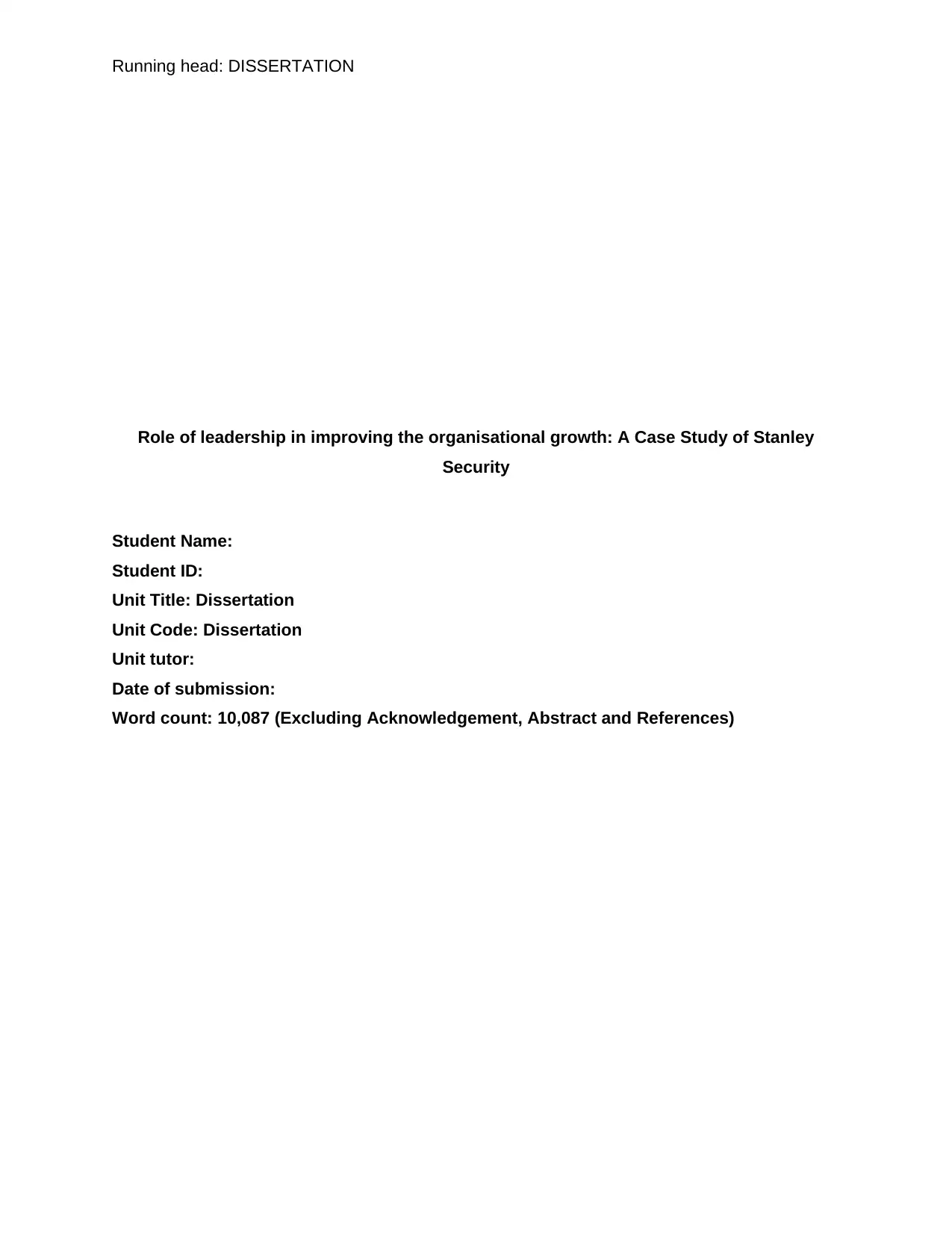
Running head: DISSERTATION
Role of leadership in improving the organisational growth: A Case Study of Stanley
Security
Student Name:
Student ID:
Unit Title: Dissertation
Unit Code: Dissertation
Unit tutor:
Date of submission:
Word count: 10,087 (Excluding Acknowledgement, Abstract and References)
Role of leadership in improving the organisational growth: A Case Study of Stanley
Security
Student Name:
Student ID:
Unit Title: Dissertation
Unit Code: Dissertation
Unit tutor:
Date of submission:
Word count: 10,087 (Excluding Acknowledgement, Abstract and References)
Paraphrase This Document
Need a fresh take? Get an instant paraphrase of this document with our AI Paraphraser

1DISSERTATION
Acknowledgement
I am thankful to every person who has provided me continuous support to complete my
research work based on ‘Role of leadership in improving the organisational growth: A
Case Study of Stanley Security’. I would also like to express heartfelt gratitude to my
professor ........... who has been my guide and constant support during the entire study
programme. I would like to thank my friends and family who have given me confidence and
support all the times during the research work. I am also very grateful to the employees of
Stanley Security who spared their valuable time and provided their responses to collect the data
for the study, and also to the management of Stanley Security, who had given me the
opportunity to conduct a study on them and provided extreme cooperation and help through the
study. Completion of the research gives me much pleasure.
Thank You.
Acknowledgement
I am thankful to every person who has provided me continuous support to complete my
research work based on ‘Role of leadership in improving the organisational growth: A
Case Study of Stanley Security’. I would also like to express heartfelt gratitude to my
professor ........... who has been my guide and constant support during the entire study
programme. I would like to thank my friends and family who have given me confidence and
support all the times during the research work. I am also very grateful to the employees of
Stanley Security who spared their valuable time and provided their responses to collect the data
for the study, and also to the management of Stanley Security, who had given me the
opportunity to conduct a study on them and provided extreme cooperation and help through the
study. Completion of the research gives me much pleasure.
Thank You.
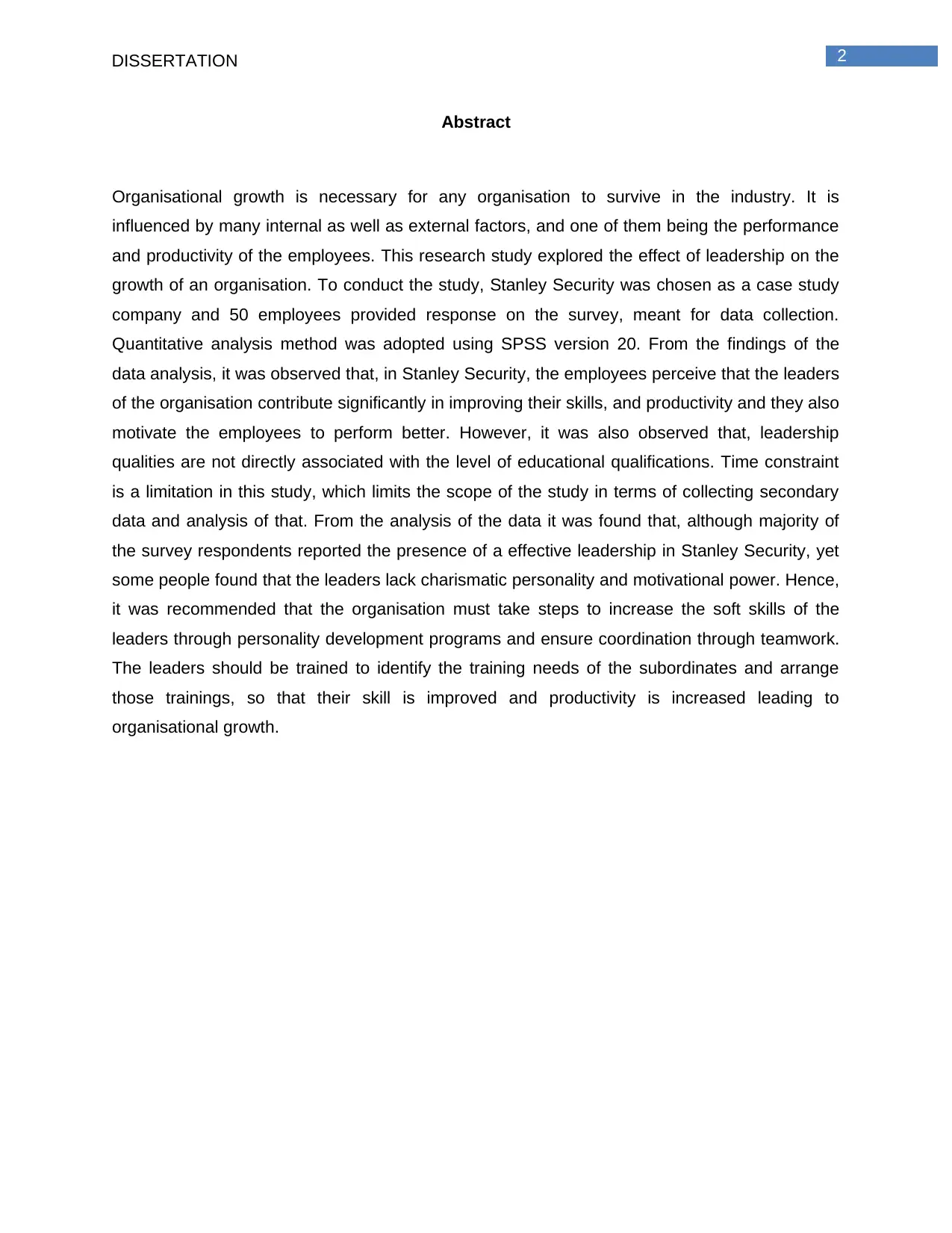
2DISSERTATION
Abstract
Organisational growth is necessary for any organisation to survive in the industry. It is
influenced by many internal as well as external factors, and one of them being the performance
and productivity of the employees. This research study explored the effect of leadership on the
growth of an organisation. To conduct the study, Stanley Security was chosen as a case study
company and 50 employees provided response on the survey, meant for data collection.
Quantitative analysis method was adopted using SPSS version 20. From the findings of the
data analysis, it was observed that, in Stanley Security, the employees perceive that the leaders
of the organisation contribute significantly in improving their skills, and productivity and they also
motivate the employees to perform better. However, it was also observed that, leadership
qualities are not directly associated with the level of educational qualifications. Time constraint
is a limitation in this study, which limits the scope of the study in terms of collecting secondary
data and analysis of that. From the analysis of the data it was found that, although majority of
the survey respondents reported the presence of a effective leadership in Stanley Security, yet
some people found that the leaders lack charismatic personality and motivational power. Hence,
it was recommended that the organisation must take steps to increase the soft skills of the
leaders through personality development programs and ensure coordination through teamwork.
The leaders should be trained to identify the training needs of the subordinates and arrange
those trainings, so that their skill is improved and productivity is increased leading to
organisational growth.
Abstract
Organisational growth is necessary for any organisation to survive in the industry. It is
influenced by many internal as well as external factors, and one of them being the performance
and productivity of the employees. This research study explored the effect of leadership on the
growth of an organisation. To conduct the study, Stanley Security was chosen as a case study
company and 50 employees provided response on the survey, meant for data collection.
Quantitative analysis method was adopted using SPSS version 20. From the findings of the
data analysis, it was observed that, in Stanley Security, the employees perceive that the leaders
of the organisation contribute significantly in improving their skills, and productivity and they also
motivate the employees to perform better. However, it was also observed that, leadership
qualities are not directly associated with the level of educational qualifications. Time constraint
is a limitation in this study, which limits the scope of the study in terms of collecting secondary
data and analysis of that. From the analysis of the data it was found that, although majority of
the survey respondents reported the presence of a effective leadership in Stanley Security, yet
some people found that the leaders lack charismatic personality and motivational power. Hence,
it was recommended that the organisation must take steps to increase the soft skills of the
leaders through personality development programs and ensure coordination through teamwork.
The leaders should be trained to identify the training needs of the subordinates and arrange
those trainings, so that their skill is improved and productivity is increased leading to
organisational growth.
⊘ This is a preview!⊘
Do you want full access?
Subscribe today to unlock all pages.

Trusted by 1+ million students worldwide
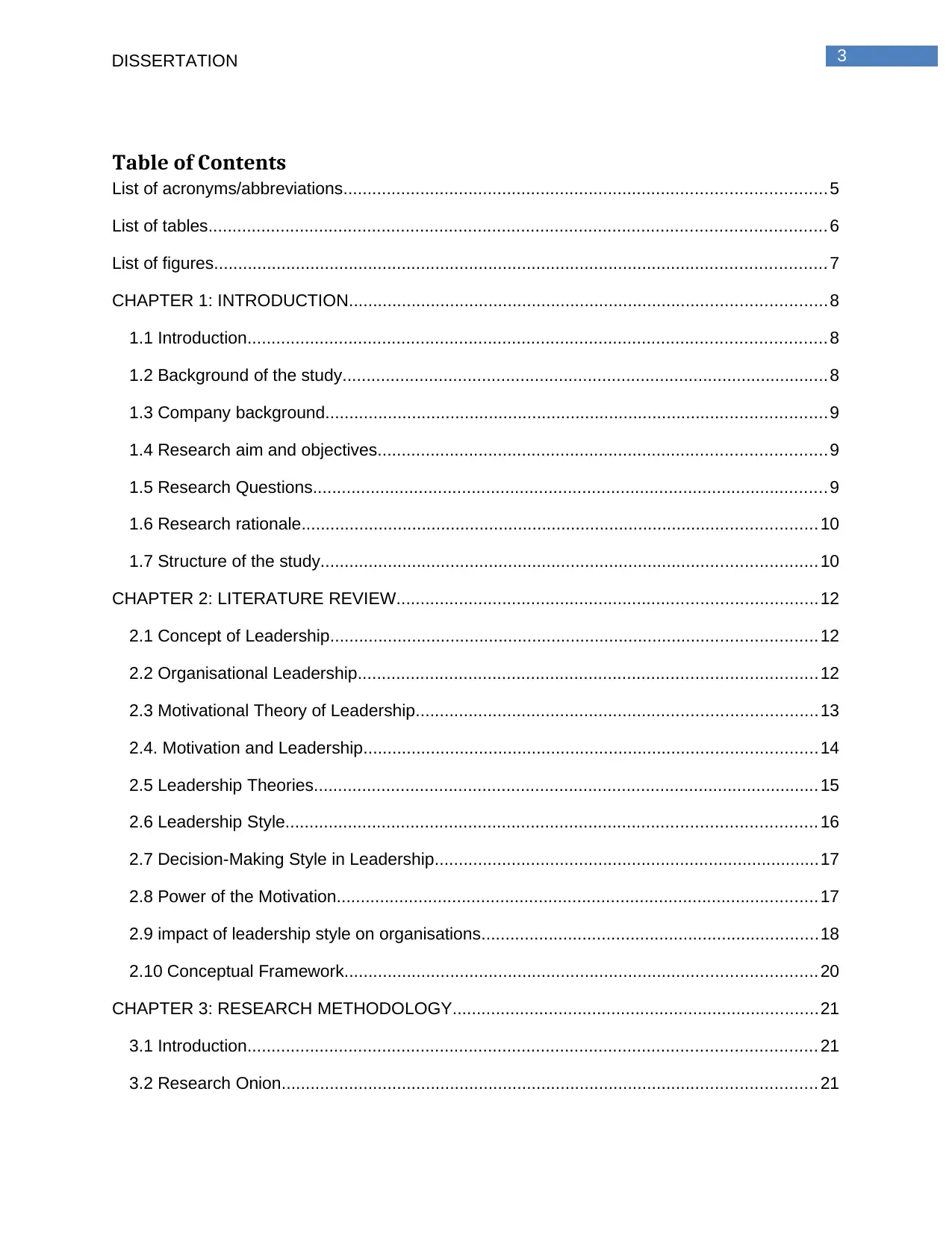
3DISSERTATION
Table of Contents
List of acronyms/abbreviations....................................................................................................5
List of tables................................................................................................................................ 6
List of figures............................................................................................................................... 7
CHAPTER 1: INTRODUCTION...................................................................................................8
1.1 Introduction........................................................................................................................ 8
1.2 Background of the study.....................................................................................................8
1.3 Company background........................................................................................................9
1.4 Research aim and objectives.............................................................................................9
1.5 Research Questions...........................................................................................................9
1.6 Research rationale........................................................................................................... 10
1.7 Structure of the study.......................................................................................................10
CHAPTER 2: LITERATURE REVIEW.......................................................................................12
2.1 Concept of Leadership.....................................................................................................12
2.2 Organisational Leadership...............................................................................................12
2.3 Motivational Theory of Leadership...................................................................................13
2.4. Motivation and Leadership..............................................................................................14
2.5 Leadership Theories.........................................................................................................15
2.6 Leadership Style.............................................................................................................. 16
2.7 Decision-Making Style in Leadership................................................................................17
2.8 Power of the Motivation....................................................................................................17
2.9 impact of leadership style on organisations......................................................................18
2.10 Conceptual Framework..................................................................................................20
CHAPTER 3: RESEARCH METHODOLOGY............................................................................21
3.1 Introduction...................................................................................................................... 21
3.2 Research Onion............................................................................................................... 21
Table of Contents
List of acronyms/abbreviations....................................................................................................5
List of tables................................................................................................................................ 6
List of figures............................................................................................................................... 7
CHAPTER 1: INTRODUCTION...................................................................................................8
1.1 Introduction........................................................................................................................ 8
1.2 Background of the study.....................................................................................................8
1.3 Company background........................................................................................................9
1.4 Research aim and objectives.............................................................................................9
1.5 Research Questions...........................................................................................................9
1.6 Research rationale........................................................................................................... 10
1.7 Structure of the study.......................................................................................................10
CHAPTER 2: LITERATURE REVIEW.......................................................................................12
2.1 Concept of Leadership.....................................................................................................12
2.2 Organisational Leadership...............................................................................................12
2.3 Motivational Theory of Leadership...................................................................................13
2.4. Motivation and Leadership..............................................................................................14
2.5 Leadership Theories.........................................................................................................15
2.6 Leadership Style.............................................................................................................. 16
2.7 Decision-Making Style in Leadership................................................................................17
2.8 Power of the Motivation....................................................................................................17
2.9 impact of leadership style on organisations......................................................................18
2.10 Conceptual Framework..................................................................................................20
CHAPTER 3: RESEARCH METHODOLOGY............................................................................21
3.1 Introduction...................................................................................................................... 21
3.2 Research Onion............................................................................................................... 21
Paraphrase This Document
Need a fresh take? Get an instant paraphrase of this document with our AI Paraphraser
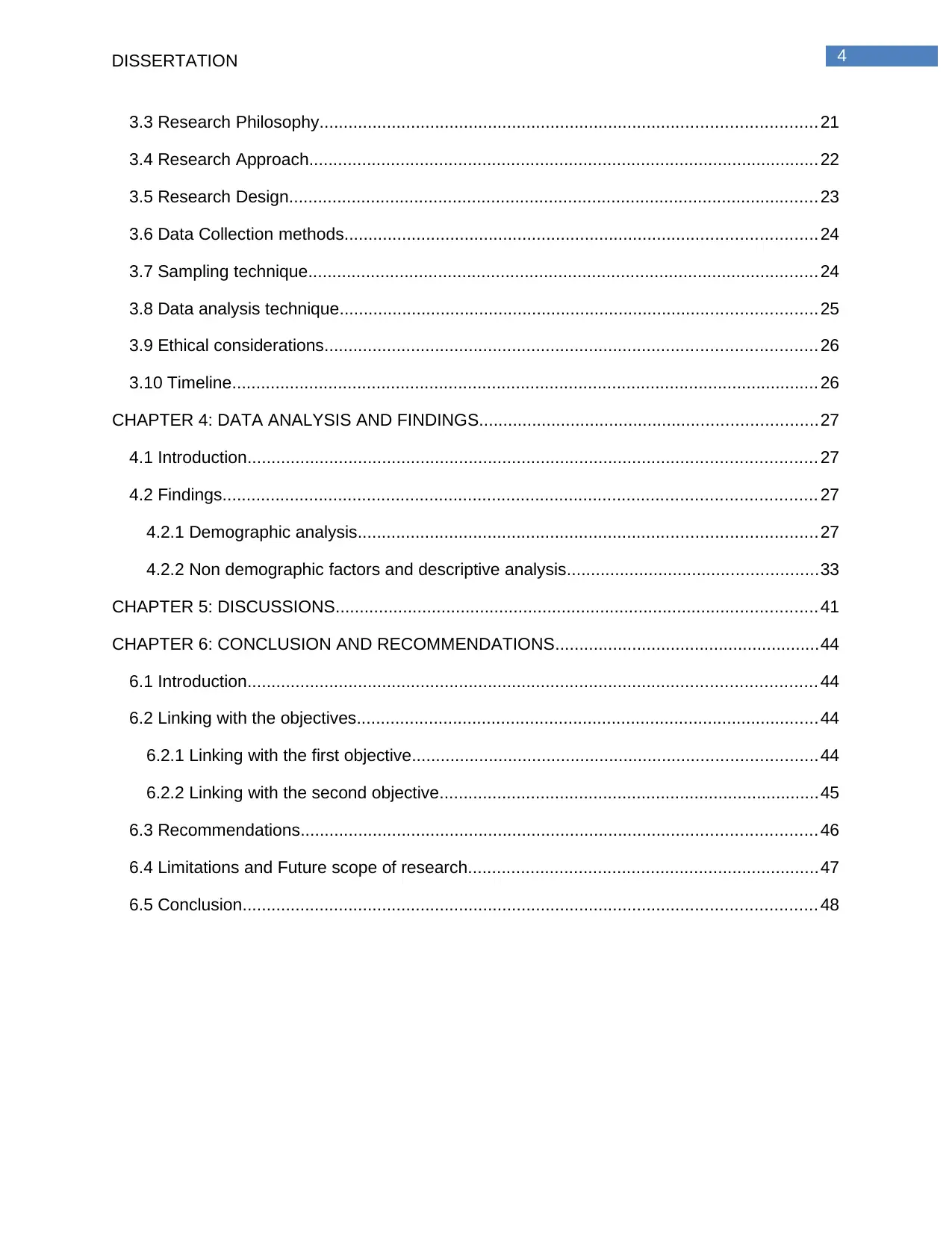
4DISSERTATION
3.3 Research Philosophy.......................................................................................................21
3.4 Research Approach..........................................................................................................22
3.5 Research Design.............................................................................................................. 23
3.6 Data Collection methods..................................................................................................24
3.7 Sampling technique..........................................................................................................24
3.8 Data analysis technique...................................................................................................25
3.9 Ethical considerations......................................................................................................26
3.10 Timeline.......................................................................................................................... 26
CHAPTER 4: DATA ANALYSIS AND FINDINGS......................................................................27
4.1 Introduction...................................................................................................................... 27
4.2 Findings........................................................................................................................... 27
4.2.1 Demographic analysis...............................................................................................27
4.2.2 Non demographic factors and descriptive analysis....................................................33
CHAPTER 5: DISCUSSIONS....................................................................................................41
CHAPTER 6: CONCLUSION AND RECOMMENDATIONS.......................................................44
6.1 Introduction...................................................................................................................... 44
6.2 Linking with the objectives................................................................................................44
6.2.1 Linking with the first objective....................................................................................44
6.2.2 Linking with the second objective...............................................................................45
6.3 Recommendations........................................................................................................... 46
6.4 Limitations and Future scope of research.........................................................................47
6.5 Conclusion....................................................................................................................... 48
3.3 Research Philosophy.......................................................................................................21
3.4 Research Approach..........................................................................................................22
3.5 Research Design.............................................................................................................. 23
3.6 Data Collection methods..................................................................................................24
3.7 Sampling technique..........................................................................................................24
3.8 Data analysis technique...................................................................................................25
3.9 Ethical considerations......................................................................................................26
3.10 Timeline.......................................................................................................................... 26
CHAPTER 4: DATA ANALYSIS AND FINDINGS......................................................................27
4.1 Introduction...................................................................................................................... 27
4.2 Findings........................................................................................................................... 27
4.2.1 Demographic analysis...............................................................................................27
4.2.2 Non demographic factors and descriptive analysis....................................................33
CHAPTER 5: DISCUSSIONS....................................................................................................41
CHAPTER 6: CONCLUSION AND RECOMMENDATIONS.......................................................44
6.1 Introduction...................................................................................................................... 44
6.2 Linking with the objectives................................................................................................44
6.2.1 Linking with the first objective....................................................................................44
6.2.2 Linking with the second objective...............................................................................45
6.3 Recommendations........................................................................................................... 46
6.4 Limitations and Future scope of research.........................................................................47
6.5 Conclusion....................................................................................................................... 48

5DISSERTATION
List of acronyms/abbreviations
SSS: Stanley Security Solutions
CEO: Chief Executive Officer
CFO: Chief Financial Officer
COO: Chief Operating Officer
MCQ: Multiple-Choice Questions
HR: Human Resource
SPSS: Statistical Package for the Social Sciences
List of acronyms/abbreviations
SSS: Stanley Security Solutions
CEO: Chief Executive Officer
CFO: Chief Financial Officer
COO: Chief Operating Officer
MCQ: Multiple-Choice Questions
HR: Human Resource
SPSS: Statistical Package for the Social Sciences
⊘ This is a preview!⊘
Do you want full access?
Subscribe today to unlock all pages.

Trusted by 1+ million students worldwide
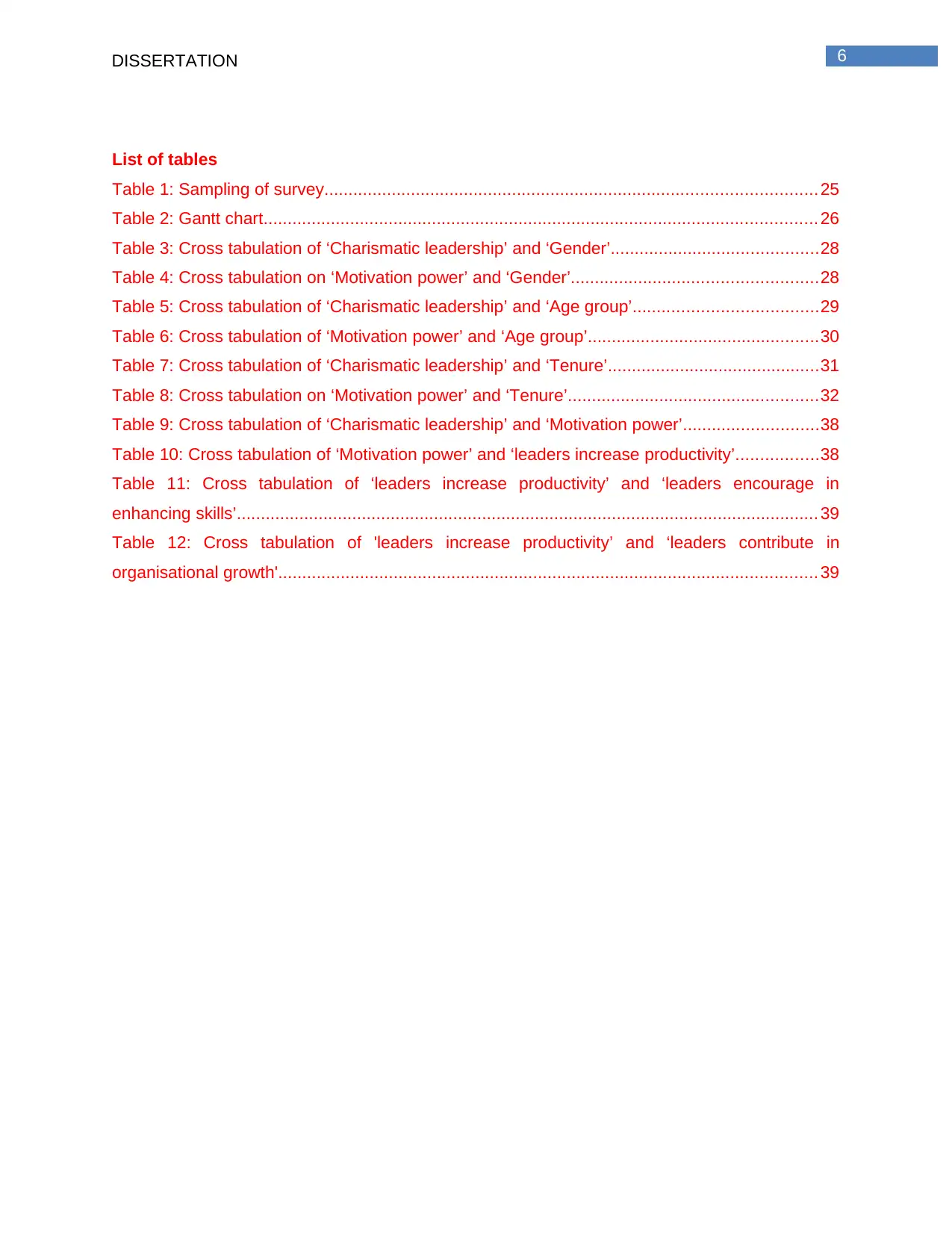
6DISSERTATION
List of tables
Table 1: Sampling of survey......................................................................................................25
Table 2: Gantt chart................................................................................................................... 26
Table 3: Cross tabulation of ‘Charismatic leadership’ and ‘Gender’...........................................28
Table 4: Cross tabulation on ‘Motivation power’ and ‘Gender’...................................................28
Table 5: Cross tabulation of ‘Charismatic leadership’ and ‘Age group’......................................29
Table 6: Cross tabulation of ‘Motivation power’ and ‘Age group’................................................30
Table 7: Cross tabulation of ‘Charismatic leadership’ and ‘Tenure’............................................31
Table 8: Cross tabulation on ‘Motivation power’ and ‘Tenure’....................................................32
Table 9: Cross tabulation of ‘Charismatic leadership’ and ‘Motivation power’............................38
Table 10: Cross tabulation of ‘Motivation power’ and ‘leaders increase productivity’.................38
Table 11: Cross tabulation of ‘leaders increase productivity’ and ‘leaders encourage in
enhancing skills’......................................................................................................................... 39
Table 12: Cross tabulation of 'leaders increase productivity’ and ‘leaders contribute in
organisational growth'................................................................................................................ 39
List of tables
Table 1: Sampling of survey......................................................................................................25
Table 2: Gantt chart................................................................................................................... 26
Table 3: Cross tabulation of ‘Charismatic leadership’ and ‘Gender’...........................................28
Table 4: Cross tabulation on ‘Motivation power’ and ‘Gender’...................................................28
Table 5: Cross tabulation of ‘Charismatic leadership’ and ‘Age group’......................................29
Table 6: Cross tabulation of ‘Motivation power’ and ‘Age group’................................................30
Table 7: Cross tabulation of ‘Charismatic leadership’ and ‘Tenure’............................................31
Table 8: Cross tabulation on ‘Motivation power’ and ‘Tenure’....................................................32
Table 9: Cross tabulation of ‘Charismatic leadership’ and ‘Motivation power’............................38
Table 10: Cross tabulation of ‘Motivation power’ and ‘leaders increase productivity’.................38
Table 11: Cross tabulation of ‘leaders increase productivity’ and ‘leaders encourage in
enhancing skills’......................................................................................................................... 39
Table 12: Cross tabulation of 'leaders increase productivity’ and ‘leaders contribute in
organisational growth'................................................................................................................ 39
Paraphrase This Document
Need a fresh take? Get an instant paraphrase of this document with our AI Paraphraser

7DISSERTATION
List of figures
Figure 1: Conceptual Framework...............................................................................................20
Figure 2: Research onion...........................................................................................................21
Figure 3: Gender profile............................................................................................................. 27
Figure 4: Age group................................................................................................................... 29
Figure 5: Designation of the participants....................................................................................30
Figure 6: Tenure in the company...............................................................................................31
Figure 7: Educational qualification.............................................................................................33
Figure 8: Charismatic leadership in the company......................................................................34
Figure 9: Leadership comes with highest educational qualification............................................34
Figure 10: Motivational power of leaders...................................................................................35
Figure 11: Leaders influence in increasing productivity..............................................................35
Figure 12: Leaders promote supportive work environment........................................................36
Figure 13: Leaders encourage in enhancing skills.....................................................................37
Figure 14: Leaders contribute in organisational growth..............................................................37
List of figures
Figure 1: Conceptual Framework...............................................................................................20
Figure 2: Research onion...........................................................................................................21
Figure 3: Gender profile............................................................................................................. 27
Figure 4: Age group................................................................................................................... 29
Figure 5: Designation of the participants....................................................................................30
Figure 6: Tenure in the company...............................................................................................31
Figure 7: Educational qualification.............................................................................................33
Figure 8: Charismatic leadership in the company......................................................................34
Figure 9: Leadership comes with highest educational qualification............................................34
Figure 10: Motivational power of leaders...................................................................................35
Figure 11: Leaders influence in increasing productivity..............................................................35
Figure 12: Leaders promote supportive work environment........................................................36
Figure 13: Leaders encourage in enhancing skills.....................................................................37
Figure 14: Leaders contribute in organisational growth..............................................................37
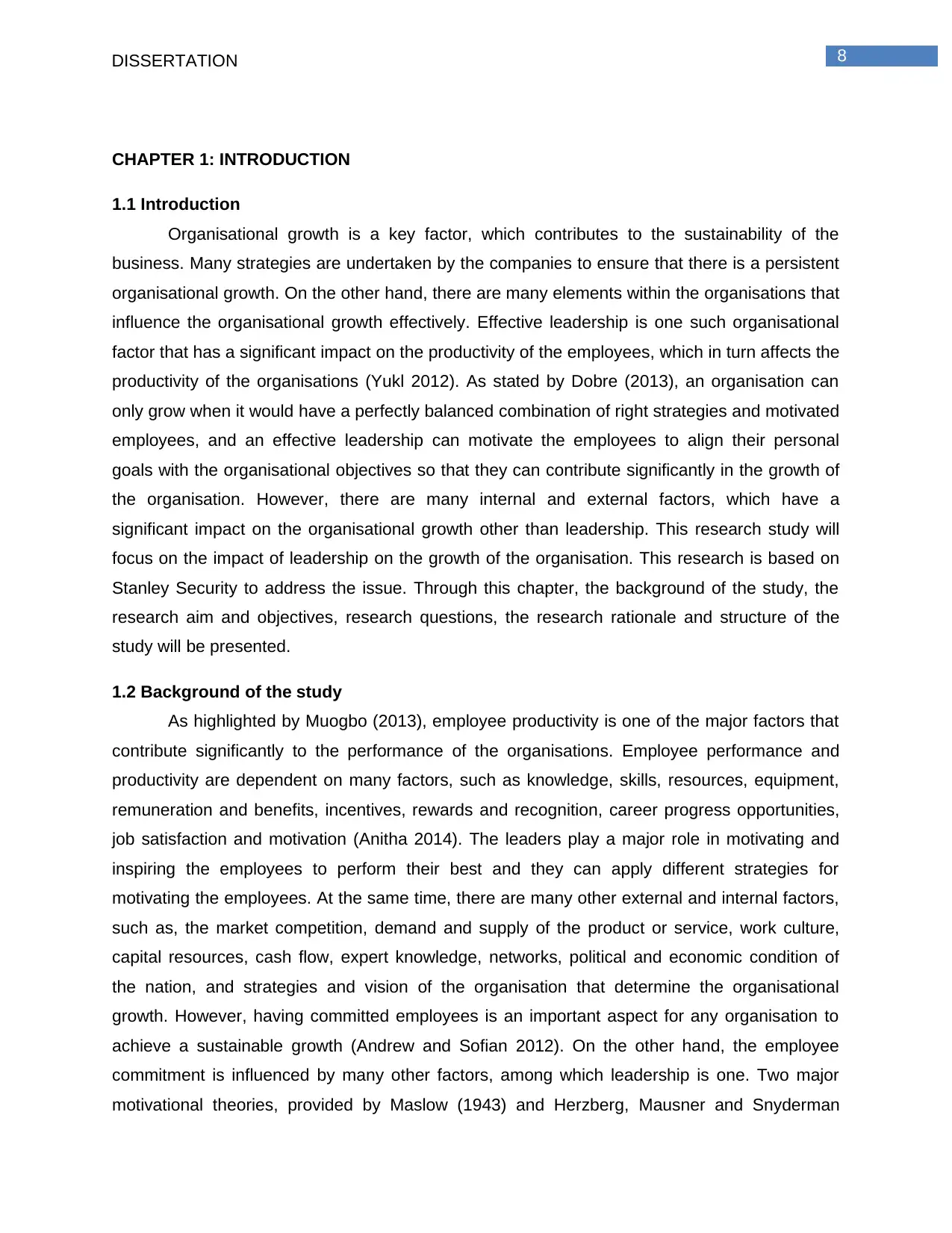
8DISSERTATION
CHAPTER 1: INTRODUCTION
1.1 Introduction
Organisational growth is a key factor, which contributes to the sustainability of the
business. Many strategies are undertaken by the companies to ensure that there is a persistent
organisational growth. On the other hand, there are many elements within the organisations that
influence the organisational growth effectively. Effective leadership is one such organisational
factor that has a significant impact on the productivity of the employees, which in turn affects the
productivity of the organisations (Yukl 2012). As stated by Dobre (2013), an organisation can
only grow when it would have a perfectly balanced combination of right strategies and motivated
employees, and an effective leadership can motivate the employees to align their personal
goals with the organisational objectives so that they can contribute significantly in the growth of
the organisation. However, there are many internal and external factors, which have a
significant impact on the organisational growth other than leadership. This research study will
focus on the impact of leadership on the growth of the organisation. This research is based on
Stanley Security to address the issue. Through this chapter, the background of the study, the
research aim and objectives, research questions, the research rationale and structure of the
study will be presented.
1.2 Background of the study
As highlighted by Muogbo (2013), employee productivity is one of the major factors that
contribute significantly to the performance of the organisations. Employee performance and
productivity are dependent on many factors, such as knowledge, skills, resources, equipment,
remuneration and benefits, incentives, rewards and recognition, career progress opportunities,
job satisfaction and motivation (Anitha 2014). The leaders play a major role in motivating and
inspiring the employees to perform their best and they can apply different strategies for
motivating the employees. At the same time, there are many other external and internal factors,
such as, the market competition, demand and supply of the product or service, work culture,
capital resources, cash flow, expert knowledge, networks, political and economic condition of
the nation, and strategies and vision of the organisation that determine the organisational
growth. However, having committed employees is an important aspect for any organisation to
achieve a sustainable growth (Andrew and Sofian 2012). On the other hand, the employee
commitment is influenced by many other factors, among which leadership is one. Two major
motivational theories, provided by Maslow (1943) and Herzberg, Mausner and Snyderman
CHAPTER 1: INTRODUCTION
1.1 Introduction
Organisational growth is a key factor, which contributes to the sustainability of the
business. Many strategies are undertaken by the companies to ensure that there is a persistent
organisational growth. On the other hand, there are many elements within the organisations that
influence the organisational growth effectively. Effective leadership is one such organisational
factor that has a significant impact on the productivity of the employees, which in turn affects the
productivity of the organisations (Yukl 2012). As stated by Dobre (2013), an organisation can
only grow when it would have a perfectly balanced combination of right strategies and motivated
employees, and an effective leadership can motivate the employees to align their personal
goals with the organisational objectives so that they can contribute significantly in the growth of
the organisation. However, there are many internal and external factors, which have a
significant impact on the organisational growth other than leadership. This research study will
focus on the impact of leadership on the growth of the organisation. This research is based on
Stanley Security to address the issue. Through this chapter, the background of the study, the
research aim and objectives, research questions, the research rationale and structure of the
study will be presented.
1.2 Background of the study
As highlighted by Muogbo (2013), employee productivity is one of the major factors that
contribute significantly to the performance of the organisations. Employee performance and
productivity are dependent on many factors, such as knowledge, skills, resources, equipment,
remuneration and benefits, incentives, rewards and recognition, career progress opportunities,
job satisfaction and motivation (Anitha 2014). The leaders play a major role in motivating and
inspiring the employees to perform their best and they can apply different strategies for
motivating the employees. At the same time, there are many other external and internal factors,
such as, the market competition, demand and supply of the product or service, work culture,
capital resources, cash flow, expert knowledge, networks, political and economic condition of
the nation, and strategies and vision of the organisation that determine the organisational
growth. However, having committed employees is an important aspect for any organisation to
achieve a sustainable growth (Andrew and Sofian 2012). On the other hand, the employee
commitment is influenced by many other factors, among which leadership is one. Two major
motivational theories, provided by Maslow (1943) and Herzberg, Mausner and Snyderman
⊘ This is a preview!⊘
Do you want full access?
Subscribe today to unlock all pages.

Trusted by 1+ million students worldwide
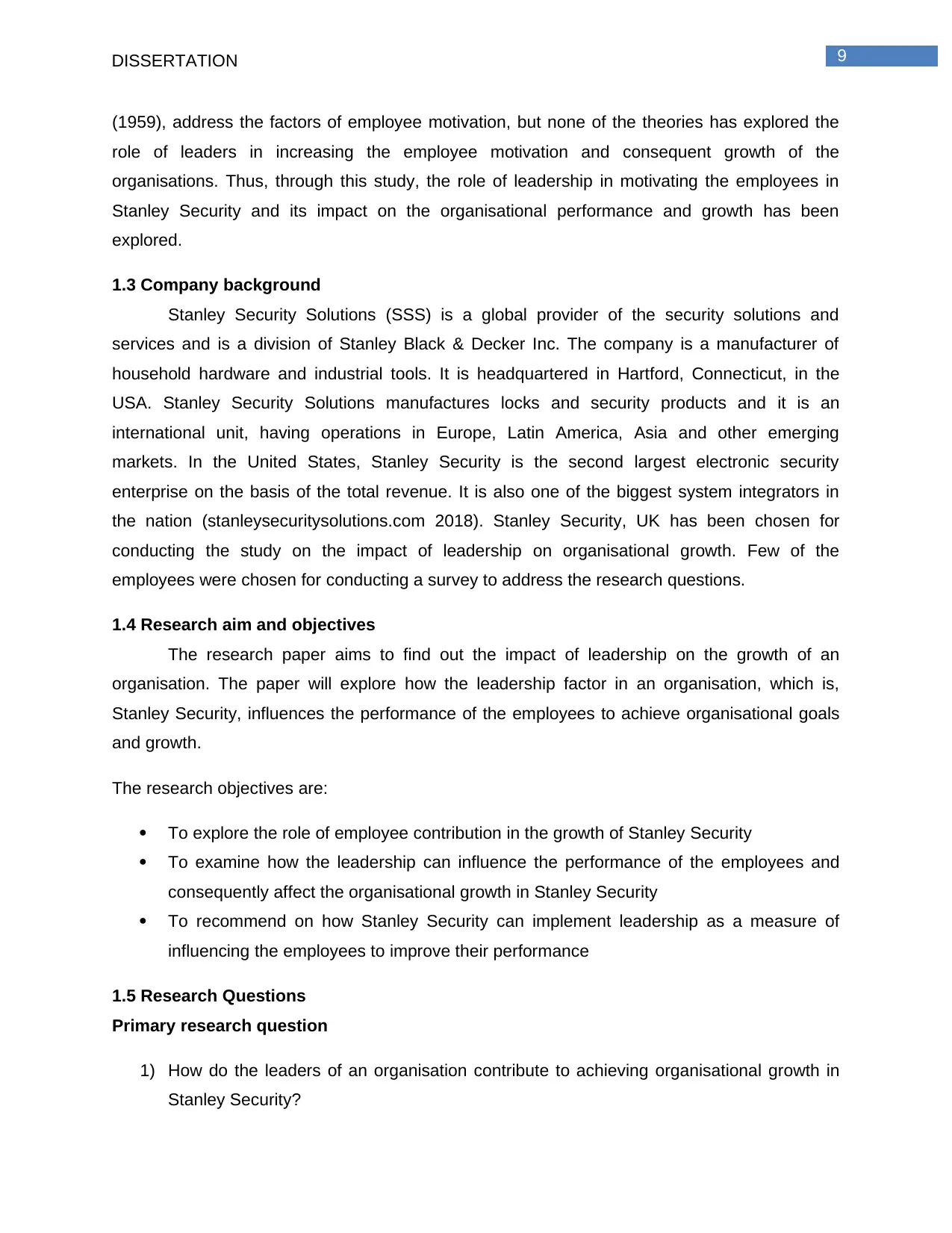
9DISSERTATION
(1959), address the factors of employee motivation, but none of the theories has explored the
role of leaders in increasing the employee motivation and consequent growth of the
organisations. Thus, through this study, the role of leadership in motivating the employees in
Stanley Security and its impact on the organisational performance and growth has been
explored.
1.3 Company background
Stanley Security Solutions (SSS) is a global provider of the security solutions and
services and is a division of Stanley Black & Decker Inc. The company is a manufacturer of
household hardware and industrial tools. It is headquartered in Hartford, Connecticut, in the
USA. Stanley Security Solutions manufactures locks and security products and it is an
international unit, having operations in Europe, Latin America, Asia and other emerging
markets. In the United States, Stanley Security is the second largest electronic security
enterprise on the basis of the total revenue. It is also one of the biggest system integrators in
the nation (stanleysecuritysolutions.com 2018). Stanley Security, UK has been chosen for
conducting the study on the impact of leadership on organisational growth. Few of the
employees were chosen for conducting a survey to address the research questions.
1.4 Research aim and objectives
The research paper aims to find out the impact of leadership on the growth of an
organisation. The paper will explore how the leadership factor in an organisation, which is,
Stanley Security, influences the performance of the employees to achieve organisational goals
and growth.
The research objectives are:
To explore the role of employee contribution in the growth of Stanley Security
To examine how the leadership can influence the performance of the employees and
consequently affect the organisational growth in Stanley Security
To recommend on how Stanley Security can implement leadership as a measure of
influencing the employees to improve their performance
1.5 Research Questions
Primary research question
1) How do the leaders of an organisation contribute to achieving organisational growth in
Stanley Security?
(1959), address the factors of employee motivation, but none of the theories has explored the
role of leaders in increasing the employee motivation and consequent growth of the
organisations. Thus, through this study, the role of leadership in motivating the employees in
Stanley Security and its impact on the organisational performance and growth has been
explored.
1.3 Company background
Stanley Security Solutions (SSS) is a global provider of the security solutions and
services and is a division of Stanley Black & Decker Inc. The company is a manufacturer of
household hardware and industrial tools. It is headquartered in Hartford, Connecticut, in the
USA. Stanley Security Solutions manufactures locks and security products and it is an
international unit, having operations in Europe, Latin America, Asia and other emerging
markets. In the United States, Stanley Security is the second largest electronic security
enterprise on the basis of the total revenue. It is also one of the biggest system integrators in
the nation (stanleysecuritysolutions.com 2018). Stanley Security, UK has been chosen for
conducting the study on the impact of leadership on organisational growth. Few of the
employees were chosen for conducting a survey to address the research questions.
1.4 Research aim and objectives
The research paper aims to find out the impact of leadership on the growth of an
organisation. The paper will explore how the leadership factor in an organisation, which is,
Stanley Security, influences the performance of the employees to achieve organisational goals
and growth.
The research objectives are:
To explore the role of employee contribution in the growth of Stanley Security
To examine how the leadership can influence the performance of the employees and
consequently affect the organisational growth in Stanley Security
To recommend on how Stanley Security can implement leadership as a measure of
influencing the employees to improve their performance
1.5 Research Questions
Primary research question
1) How do the leaders of an organisation contribute to achieving organisational growth in
Stanley Security?
Paraphrase This Document
Need a fresh take? Get an instant paraphrase of this document with our AI Paraphraser
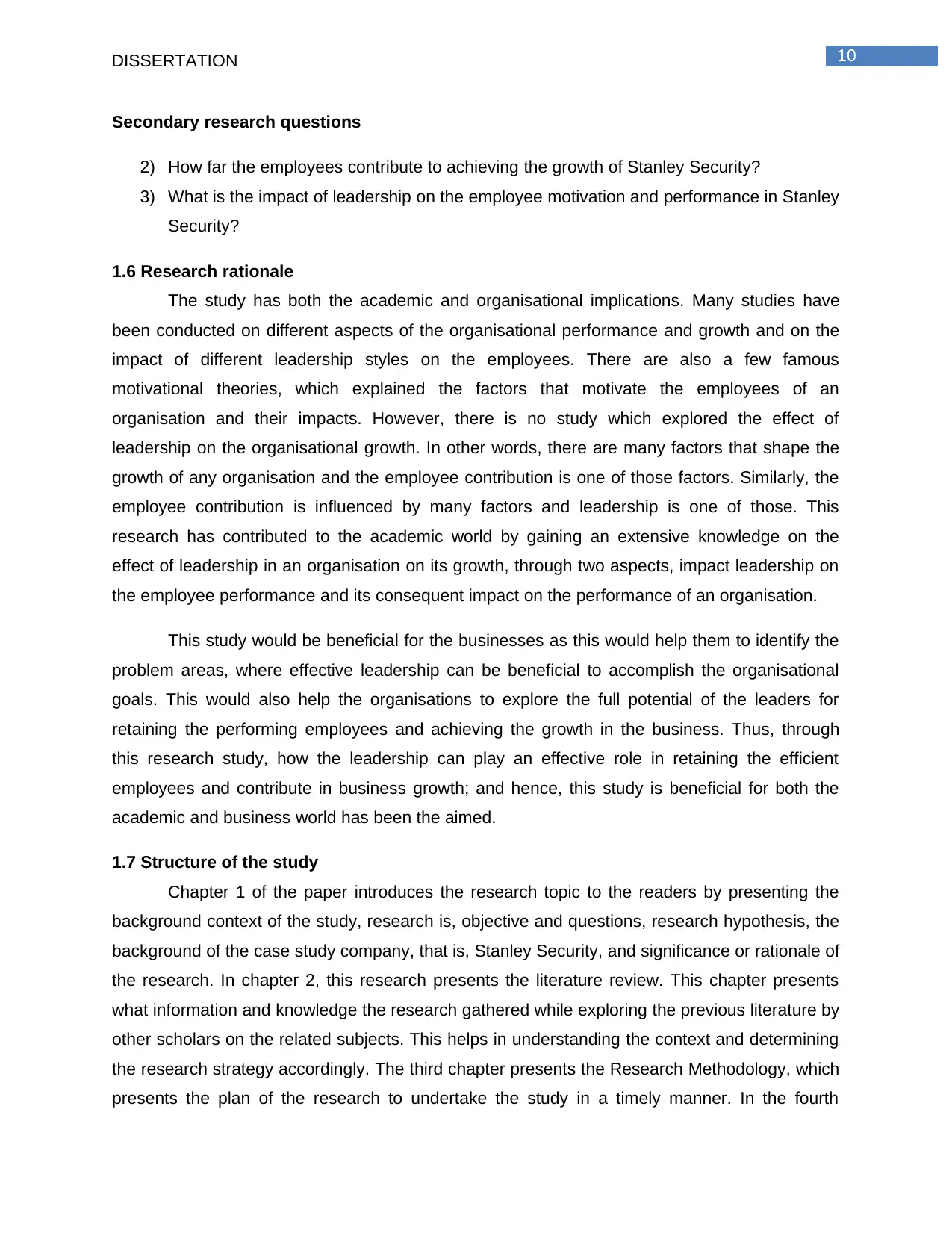
10DISSERTATION
Secondary research questions
2) How far the employees contribute to achieving the growth of Stanley Security?
3) What is the impact of leadership on the employee motivation and performance in Stanley
Security?
1.6 Research rationale
The study has both the academic and organisational implications. Many studies have
been conducted on different aspects of the organisational performance and growth and on the
impact of different leadership styles on the employees. There are also a few famous
motivational theories, which explained the factors that motivate the employees of an
organisation and their impacts. However, there is no study which explored the effect of
leadership on the organisational growth. In other words, there are many factors that shape the
growth of any organisation and the employee contribution is one of those factors. Similarly, the
employee contribution is influenced by many factors and leadership is one of those. This
research has contributed to the academic world by gaining an extensive knowledge on the
effect of leadership in an organisation on its growth, through two aspects, impact leadership on
the employee performance and its consequent impact on the performance of an organisation.
This study would be beneficial for the businesses as this would help them to identify the
problem areas, where effective leadership can be beneficial to accomplish the organisational
goals. This would also help the organisations to explore the full potential of the leaders for
retaining the performing employees and achieving the growth in the business. Thus, through
this research study, how the leadership can play an effective role in retaining the efficient
employees and contribute in business growth; and hence, this study is beneficial for both the
academic and business world has been the aimed.
1.7 Structure of the study
Chapter 1 of the paper introduces the research topic to the readers by presenting the
background context of the study, research is, objective and questions, research hypothesis, the
background of the case study company, that is, Stanley Security, and significance or rationale of
the research. In chapter 2, this research presents the literature review. This chapter presents
what information and knowledge the research gathered while exploring the previous literature by
other scholars on the related subjects. This helps in understanding the context and determining
the research strategy accordingly. The third chapter presents the Research Methodology, which
presents the plan of the research to undertake the study in a timely manner. In the fourth
Secondary research questions
2) How far the employees contribute to achieving the growth of Stanley Security?
3) What is the impact of leadership on the employee motivation and performance in Stanley
Security?
1.6 Research rationale
The study has both the academic and organisational implications. Many studies have
been conducted on different aspects of the organisational performance and growth and on the
impact of different leadership styles on the employees. There are also a few famous
motivational theories, which explained the factors that motivate the employees of an
organisation and their impacts. However, there is no study which explored the effect of
leadership on the organisational growth. In other words, there are many factors that shape the
growth of any organisation and the employee contribution is one of those factors. Similarly, the
employee contribution is influenced by many factors and leadership is one of those. This
research has contributed to the academic world by gaining an extensive knowledge on the
effect of leadership in an organisation on its growth, through two aspects, impact leadership on
the employee performance and its consequent impact on the performance of an organisation.
This study would be beneficial for the businesses as this would help them to identify the
problem areas, where effective leadership can be beneficial to accomplish the organisational
goals. This would also help the organisations to explore the full potential of the leaders for
retaining the performing employees and achieving the growth in the business. Thus, through
this research study, how the leadership can play an effective role in retaining the efficient
employees and contribute in business growth; and hence, this study is beneficial for both the
academic and business world has been the aimed.
1.7 Structure of the study
Chapter 1 of the paper introduces the research topic to the readers by presenting the
background context of the study, research is, objective and questions, research hypothesis, the
background of the case study company, that is, Stanley Security, and significance or rationale of
the research. In chapter 2, this research presents the literature review. This chapter presents
what information and knowledge the research gathered while exploring the previous literature by
other scholars on the related subjects. This helps in understanding the context and determining
the research strategy accordingly. The third chapter presents the Research Methodology, which
presents the plan of the research to undertake the study in a timely manner. In the fourth
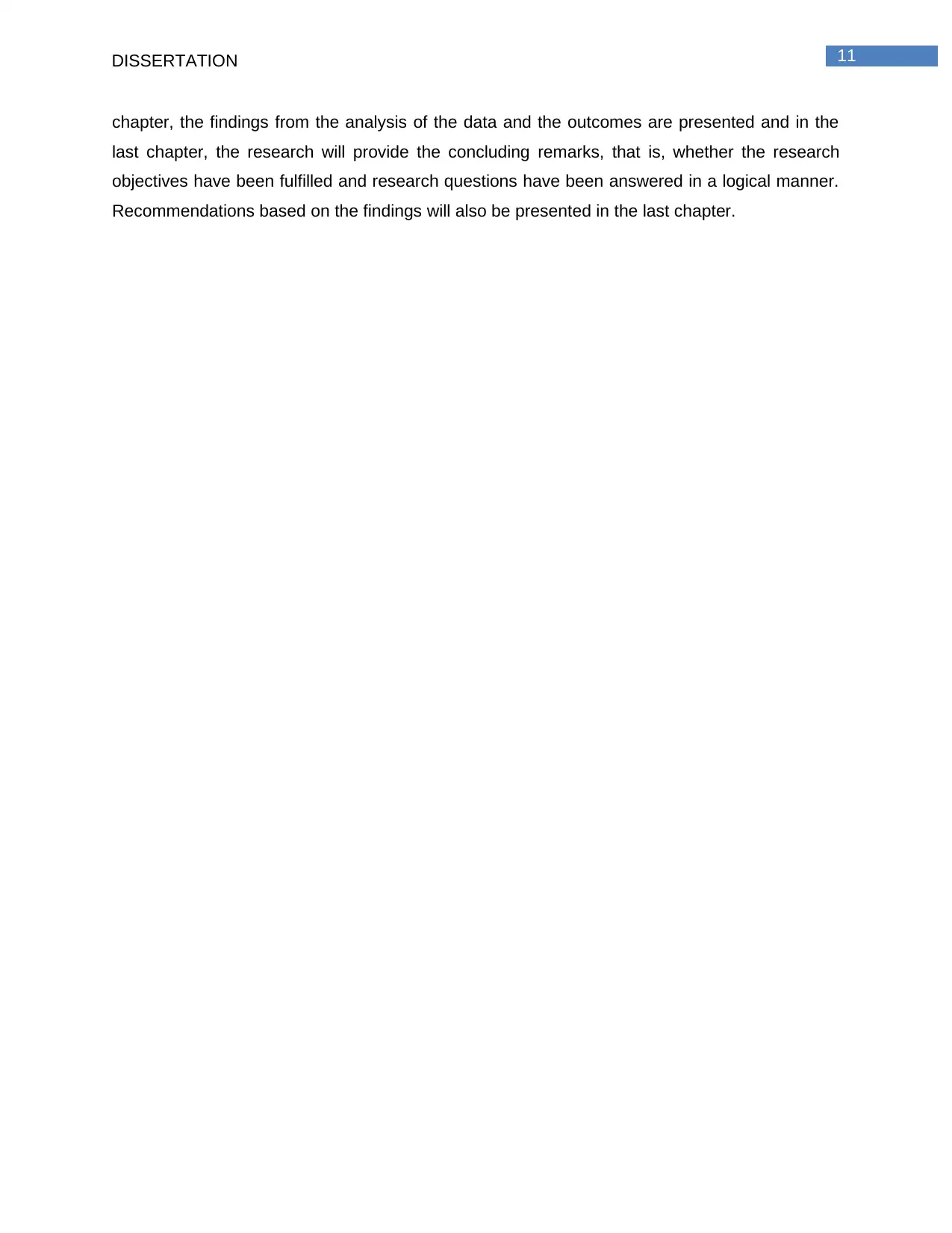
11DISSERTATION
chapter, the findings from the analysis of the data and the outcomes are presented and in the
last chapter, the research will provide the concluding remarks, that is, whether the research
objectives have been fulfilled and research questions have been answered in a logical manner.
Recommendations based on the findings will also be presented in the last chapter.
chapter, the findings from the analysis of the data and the outcomes are presented and in the
last chapter, the research will provide the concluding remarks, that is, whether the research
objectives have been fulfilled and research questions have been answered in a logical manner.
Recommendations based on the findings will also be presented in the last chapter.
⊘ This is a preview!⊘
Do you want full access?
Subscribe today to unlock all pages.

Trusted by 1+ million students worldwide
1 out of 54
Related Documents
Your All-in-One AI-Powered Toolkit for Academic Success.
+13062052269
info@desklib.com
Available 24*7 on WhatsApp / Email
![[object Object]](/_next/static/media/star-bottom.7253800d.svg)
Unlock your academic potential
Copyright © 2020–2025 A2Z Services. All Rights Reserved. Developed and managed by ZUCOL.





